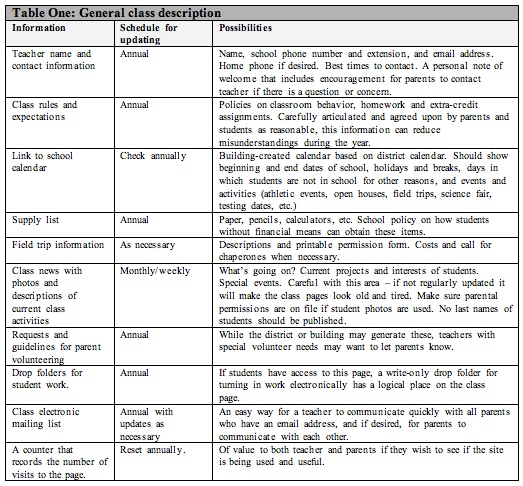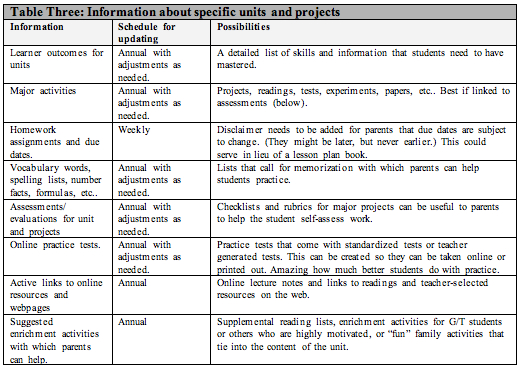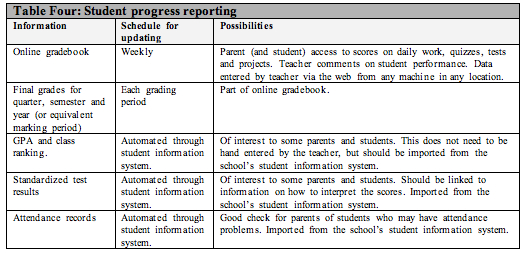Teacher Webpages That Build Parent Partnerships
MultiMedia Schools, September 2000
A story
Indulge me for a moment by reading a personal tale of parental frustration.
When my son Brady was in the fifth-grade, he came home with a report card that was, shall we say, less than impressive. This bright, hard working boy was getting D’s in social studies, science, and health. The first parent-teacher conference of the year was held ten weeks after school began, and it wasn’t until then that I learned of the problems he was having.Brady’s teacher missed a tremendous opportunity by not enlisting my help and the help of the other children’s parents in her class. Over one-fourth of the year was gone before I knew my son was having problems. Even had I known he was struggling, I did not know enough about the curricular content or teacher’s expectations to know how to help.
At the conference, I asked his teacher a favor. “Please let me know what Brady needs to know in these areas, when the test dates are, and when the projects are due. I will help make sure he knows what he needs to know!”
A bit flustered, the teacher said she would get back to me.
I never saw the list of competencies or test dates, but I also noticed Brady never received less than a B in her class again. While at the time I viewed this as victory for proactive parenting, I have since worried that the skills and knowledge Brady should have gained during that year fell by the wayside.
Increasing parental involvement
Genuine, regular, real-time collaboration with parents can make a positive difference in a child’s learning experience. Parents of children with work completion problems can become allies in helping these children manage their time and turn in quality work. Answers to questions about class rules, policies, and supplies should be readily available.
The problem is that collaboration like this takes great communication and planning – and that takes time.
Happily, teacher created webpages available on the Internet can help simplify those communication and planning efforts. Sure, most if not all of information an actively involved parent might like to have could be made available through printed materials sent home with students and through earlier, more regularly scheduled face-to-face conferences. But as we all know, print material sometimes doesn’t make it home or out of the backpack. Conferences are difficult to schedule and are real time eaters. The web can help overcome these problems. (For parents without home Internet access, such webpages can be readily printed by the teacher and distributed by traditional means.)
Purposes of class webpages
A well-designed class webpage can serve a variety of purposes. These purposes include:
• Providing a general description of the classroom or course. (Table One)
• Providing a general outline and timeline of the units covered. (Table Two)
• Providing specific information about individual units or projects. (Table Three)
• Providing real-time information about the progress of individual students. (Table Four)
Details of the kinds of information that might be provided on a class webpage are in the tables below.
That’s a lot of information that I as a parent would love to have. Just think, Junior comes home, plops on the sofa with remote in hand. “How’s the homework situation?” you ask. “Under control. Got it done in study hall,” replies Junior. You double-check by logging on to the class webpage, enter your personal username and password, and find that Junior has missing daily assignments and did not do well in the last test. The assessment checklist for a big project that is due soon is there too. Ah, something to talk about at suppertime.
As a parent, I can also look to see if my child has any areas in which he or she needs special help. I can work with the school to see that tutoring or a special class might be offered. My goal as a parent is the same as the school’s: to make certain my child succeeds to the very best of his or her ability.
Providing easy implementation
But that is also a lot of information for a teacher to not only get online, but to keep current. Those of us with webpages know that keeping them current, accurate and organized is an ongoing chore. But there are strategies that can be used to reduce the work and anxiety associated with maintaining a website. These strategies include:
1. Using forms to create webpages instead of creating them with a webpage editor.
While the use of editors such as FrontPage have made the creation of webpages much easier, creating and maintaining a website using web-based forms is possible without needing to know any html authoring. A “fill-in-the-blank” approach that automates organizational links and into which information already word-processed can be pasted eases both site creation and updating. It also leads to a uniform school-wide look and consistent placement of information that will ease parental access.
While a variety of commercial websites (www.eplay.com, www.highwired.com, www.achieve.com) offer such forms and storage for teacher pages, our district is contracting with a company to help us develop a customized web interface and forms. These pages will include integrated access to an online grading program. The pages will also import information like attendance from our student management system. Remember also that “free” services are usually supported by commercial messages and parents might view these messages as product endorsement by the school.
Much of the information that should be available from individual class sites can be provided by links to district sources of curricular information. Does every third grade teacher need to enter information about the reading curriculum when it is standard within a district? Do all world history classes in a district have common objectives and projects? Can the page link to descriptions of the state requirements that are met within the class? Creating and linking to such generic sites can ease the burden of the classroom teacher.
2. Phasing in the project.
In the Mankato school district we will be taking a multi-year approach to the creation of class sites. The plan looks like this:
Year One 2000-2001
Work with developer to design web forms.
Pilot online grade book at volunteer site.
Three to four hour training session on online gradebook.
Pilot online grade book with volunteer teachers.
Begin planning online site for holding curriculum and assessments.
Begin planning online site for describing elementary curriculum.
Year Two: 2001-2002
All teachers will have a class page that includes items 1, 2, and 3 from Table One. Three to four hour workshop for all teachers on using the forms. Teachers wishing to provide more information should be encouraged to do so.
Implement website for curriculum and assessments.
Implement website for describing elementary curriculum.
Year Three: 2002-2003
All teachers will have a class page that includes items 1, 2, and 3 from Table One.
All teachers will be using online gradebook. Three to four hour training session on online gradebook for all teachers.
Teachers wishing to provide more information should be encouraged to do so.
Years Four and beyond
All teachers will have a class page that includes items 1, 2, and 3 from Table One.
All teachers will be using online gradebook.
Buildings will add other items from table per building plan.
Teachers wishing to provide more information should be encouraged to do so.
For the first year, we are asking all teachers to have a page that simply lists contact information (items 1, 2 and 3 in Table One). We will also be piloting the online grade book at a volunteer site. Our current electronic gradebook will be replaced as we get new staff using it or current staff members asking to switch to it. We anticipate that the ease with which grades can be entered from home will be an incentive to move to the online gradebook.
We will also encourage increasing the amount of information on class webpages goals for buildings in the district. My sense is that the information contained on developed pages will be useful enough to parents that they will also encourage teachers to make it available online.
3. Waiting until the teacher is comfortable with the program before making the gradebook available online.
Sharing the kinds of information contained in their gradebooks with parents will be a new and possibly disturbing idea for some teachers. We anticipate teachers using the gradebook for at least a semester before giving parents access to it.
A major concern of many educators is the security and privacy of the information being made available. Both teachers and parents need to know that parents will have access to only their child’s information and that security and password confidentiality needs to be taken seriously. We will ask parents to come to school to pick up their usernames and passwords in person.
4. Providing support.
We all know that nothing helps a project succeed like great support, and nothing kills it faster than a lack of training and working equipment. We will work to provide our teachers with powerful, reliable desktop computers and networks. Training will be scheduled during the school day or during inservice times. Our school media specialists have additional training on both the web-based forms and general webpage creation so they can provide in-building support to teachers when needed.
Conclusion
As a parent, I currently have the choice of sending my son to the local public school in my neighborhood, to a public school across town, to any public school in a variety of nearby communities, to a variety of private and parochial schools, or to a local charter school. I can choose to home school my son, enroll him in a virtual school, or get him early admittance to a post-secondary institution. I can as readily choose the kind of school I want for Brady as I now choose his church, dental clinic, or clothing store.
As a savvy consumer, on what will I base my choice of school? Convenience, of course. But I will also want to be sure the teachers in my son’s school communicate well, are organized, and see me as a valuable partner in his education. As important as a good education is to his future, I can in good conscience do nothing less. Schools can take an active role in making parent-consumers aware of the quality of their teachers and programs by having useful, professional class webpages.



